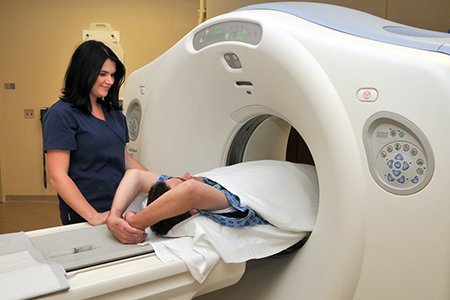CT Scans
What is a CT scan?
 A CT scan uses X-rays and special computers to create detailed images of sections of the body. We use CT scans to locate and diagnose conditions like:
A CT scan uses X-rays and special computers to create detailed images of sections of the body. We use CT scans to locate and diagnose conditions like:
- Blocked blood vessels
- Infections
- Tumors (noncancerous and cancerous)
CT tests we offer
We use CT scans to diagnose a number of conditions. The CT scans we offer include:
- Coronary Calcium CT Scan, which allows doctors to see the accumulation of calcium in the arteries of the heart
- CT enterogram, which produces images of the small intestine and other areas of the abdomen so we can diagnose gastrointestinal disorders and inflammatory bowel diseases.
- Three types of CT scans with contrast, which include:
- CT with IV contrast, which involves a contrast material injection to produce better pictures of difficult-to-see organs
- CT with oral contrast, which involves contrast material in a drink
- CT with IV and oral contrast, which combines a drink and an injection containing contrast material
- CT scan without contrast, for CT scans that don’t require contrast material to produce a clear picture
- Heart CT scan, which helps us measure how the heart functions and see any problems with the heart’s arteries
Our CT division is accredited by the American College of Radiology. All of our imaging technologists are CT-certified by the American Registry of Radiologic Technologists.
What can I expect during my CT scan?
We’ll give you information to help you prepare for your exam. Some tests may require blood work at a separate appointment before your exam. Please bring a list of your current medications to your test appointment, along with any other materials your doctor requests. Most scans are done on an outpatient basis, and if you are pregnant, it’s important to tell your doctor prior to the test.
During the test, you’ll lie on a table, which will slide into the scanner. If your test requires an injection of contrast material, you may feel warm or flushed during the injection. You will have to lie still during the test, and your technologist may ask you to hold your breath at certain points during the exam. This is so we can get the clearest picture possible to accurately diagnose your condition.
.svg?iar=0&hash=F6049510E33E4E6D8196C26CCC0A64A4)

/hfh-logo-main--white.svg?iar=0&hash=ED491CBFADFB7670FAE94559C98D7798)